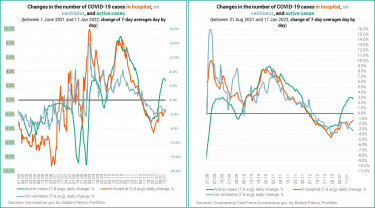COVID-19: Hospitalisations, deaths picking up as Omicron wave kicks in


A year ago, the longer-term percent positive averages were all subsiding, while this year the Omicron variant has made sure the fifth wave in the coronavirus pandemic starts before the fourth wave is over. It is spreading extremely fast, doubling the number of cases every two days.

As the erratic testing practices have rendered the daily and even the short-term average positivity rates practically useless, we need to use longer-term averages to see where the pandemic is headed.

Here's our 'new' indicator, the 7-d / 28-day average and its 7-day average, for two periods: starting from 1 October 2021 and starting from 1 September 2020. Both are at their mid-Nov 2021 levels.

The 7-day average was last this high at the end of November 2020!


The 7-day rolling average of new COVID-19 keeps on rising, and the number of Covid deaths is likely to follow suit, unless the Omicron variant causes less severe disease than Delta. While this may be true on average, experts of the World Health Organisation (WHO) warned against taking Omicron lightly.
Maria Van Kerkhove, the WHO’s Covid-19 technical lead, warned last week that "it is not just a mild disease", stressing that "this is really important because people are still being hospitalized for Omicron."
Dr. Mike Ryan, director of the WHO’s health emergencies program, said last Wednesday that Omicron represents a “massive threat” to the lives of the unvaccinated.

As you can see on the right-hand graph above and the one below, the 7-day average of Covid deaths has also started to rise, which is not really a surprise in light of the sharply rising number of new cases.

How's the situation in hospitals?
The following charts more or less speak for themselves, but let's see what they are showing.
According to 3-day averages, the number of Covid patients in hospital has been dropping since 6 December 2021, which almost exactly matches the turnaround a year earlier (8 Dec), although the numbers last year were higher. Despite fewer people in hospital, a lot more needed mechanical ventilation at the peak of the previous (fourth) wave than a year earlier, and it was the case even up to a few days ago; while the 3-day average is now lower than a year ago.
Comparing the accumulated number of cases and the time spent in hospital and on ventilator we find that both the In hospital / Accumulated cases and On ventilator / Accumulated cases ratios were higher in the period under review in 2020/21 than in 2021/22. A turnaround in the latter occurred on 11 November last year.

As the number of ventilated Covid patients has been dropping more than the number of Covid patients in hospital, the Ventilated / Hospitalised ratio has also started to fall.

On the charts below the 0% line is important. When the curves are under 0% there’s a decline, when they go over 0% it’s an increase.
More importantly, when a value is north of 0% but the curve descends, it means an increase at a slowing rate, rather than a decrease. If the curve is above 0% and ascending, it is an increase at an accelerating rate. When we are under 0% and the curve goes lower, it translates into an accelerating decrease, and when it goes up it marks a decelerating decrease. As you can see, we are witnessing the latter here, and there was a turnaround in the improvement around 27-29 December. The number of active cases started to go up at an increasing rate at that time and the pace has only picked up. The changes in terms of hospitalisations and mechanical ventilation have been showing a similar start but then a different and mixed pattern. We need data for a couple of more days to see if the trend is changing for the worse or not, but an improvement would be surprising. The ascending orange curve suggests that the blue one will follow suit shortly.

The left-hand chart clearly shows that while the number of accumulated cases is way higher than a year ago, the aggregate number of days spent in hospital is much lower. The right-hand chart shows the aggregate number of days spent on ventilator is currently higher than a year go despite less time spent in hospitals.

The aggregate number of Covid deaths in the period under review is only some 2.2% lower than a year ago. Also, while the accumulated number of days Covid patients spend in hospital is about a quarter smaller than a year ago, the accumulated number of days spent in ICUs (practically on ventilator) is 12% higher.


Vaccination
While about one third of the population (3.4 mn people) are inoculated with three doses of COVID-19 vaccines, about 3.5 million people have not received a single shot yet. Also, as the effectiveness of vaccines wanes over time, about three million Hungarians have diminished or no protection against coronavirus infection, even after two jabs.
The cabinet has announced a new vaccination campaign for January where Hungarians may, after on-site registration, ask for their first, second or third dose of a COVID-19 vaccine. The shots will be administered at vaccination locations between 2 and 6 p.m. on Thursdays and Fridays and between 10 a.m. and 6 p.m. on Saturdays.
Hungary is to make a fourth COVID-19 shot available to people who ask for it, after a consultation with a doctor, Prime Minister Viktor Orbán's chief of staff, Gergely Gulyás, told a news conference on Thursday.
Minister of Human Capacities Miklós Kásler said on Monday a fourth dose is recommended for those over 60 years of age that have an underlying disease, such as hypertension or diabetes, as well as for immunodeficiency conditions, for example after chemotherapy for malignant tumours, and after transplantation for all immunodeficiency conditions.


Cover photo: MTI/János Vajda










